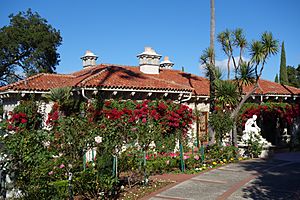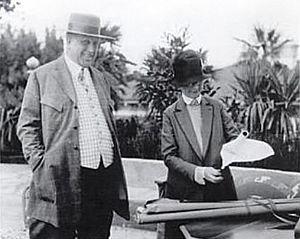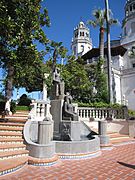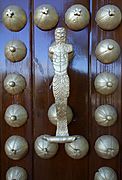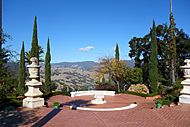Hearst Castle facts for kids
|
Hearst Castle
La Cuesta Encantada |
|
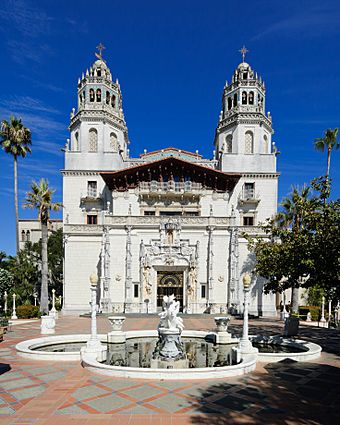
Casa Grande, inspired by the Church of Santa María la Mayor, Ronda, Spain, forms the centerpiece of Hearst's estate.
|
|
| Nearest city | San Simeon, California, United States |
|---|---|
| Area | More than 90,000 sq ft (8,400 m2) |
| Built | 1919–1947 |
| Architect | Julia Morgan |
| Architectural style | Spanish Colonial Revival, Mediterranean Revival, other late 19th and 20th century revival styles |
| NRHP reference No. | 72000253 |
Quick facts for kids Significant dates |
|
| Added to NRHP | June 22, 1972 |
Hearst Castle, known formally as La Cuesta Encantada (Spanish for "The Enchanted Hill"), is a historic estate in San Simeon, located on the Central Coast of California. Conceived by William Randolph Hearst, the publishing tycoon, and his architect Julia Morgan, the castle was built between 1919 and 1947. Today, Hearst Castle is a museum open to the public as a California State Park and registered as a National Historic Landmark and California Historical Landmark.
George Hearst, William Randolph Hearst's father, had purchased the original 40,000-acre (162 km2) estate in 1865 and Camp Hill, the site for the future Hearst Castle, was used for family camping vacations during Hearst's youth. In 1919 Hearst inherited some $11 million (equivalent to $185,669,866 in 2022) and estates including the land at San Simeon. He used his fortune to further develop his media empire of newspapers, magazines and radio stations, the profits from which supported a lifetime of building and collecting. Within a few months of Phoebe Hearst's death, he had commissioned Morgan to build "something a little more comfortable up on the hill", the genesis of the present castle. Morgan was an architectural pioneer; "America's first truly independent female architect", she was the first woman to study architecture at the School of Beaux-Arts in Paris, the first to have her own architectural practice in California and the first female winner of the American Institute of Architects Gold Medal. Working in close collaboration with Hearst for over twenty years, the castle at San Simeon is her best-known creation.
In the Roaring Twenties and into the 1930s, Hearst Castle reached its social peak. Originally intended as a family home for Hearst, his wife Millicent and their five sons, by 1925 he and Millicent had effectively separated and he held court at San Simeon with his mistress, the actress Marion Davies. Their guest list comprised most of the Hollywood stars of the period; Charlie Chaplin, Cary Grant, the Marx Brothers, Greta Garbo, Buster Keaton, Mary Pickford, Jean Harlow and Clark Gable all visited, some on multiple occasions. Political luminaries encompassed Calvin Coolidge and Winston Churchill while other notables included Charles Lindbergh, P. G. Wodehouse and Bernard Shaw. Visitors gathered each evening at Casa Grande for drinks in the Assembly Room, dined in the Refectory and watched the latest movie in the theater before retiring to the luxurious accommodation provided by the guest houses of Casa del Mar, Casa del Monte and Casa del Sol. During the days, they admired the views, rode, played tennis, bowls or golf and swam in the "most sumptuous swimming pool on earth". While Hearst entertained, Morgan built; the castle was under almost continual construction from 1920 until 1939, with work resuming after the end of World War II until Hearst's final departure in 1947.
Hearst, his castle and his lifestyle were satirized by Orson Welles in his 1941 film Citizen Kane. In the film, which Hearst sought to suppress, Charles Foster Kane's palace Xanadu is said to contain "paintings, pictures, statues, the very stones of many another palace – a collection of everything so big it can never be cataloged or appraised; enough for ten museums; the loot of the world". Welles's allusion referred to Hearst's mania for collecting; the dealer Joseph Duveen called him the "Great Accumulator". With a passion for acquisition almost from childhood, he bought architectural elements, art, antiques, statuary, silverware and textiles on an epic scale. Shortly after starting San Simeon, he began to conceive of making the castle "a museum of the best things that I can secure". Foremost among his purchases were architectural elements from Western Europe, particularly Spain; over thirty ceilings, doorcases, fireplaces and mantels, entire monasteries, paneling and a medieval tithe barn were purchased, shipped to Hearst's Brooklyn warehouses and transported on to California. Much was then incorporated into the fabric of Hearst Castle. In addition, he built up collections of more conventional art and antiques of high quality; his assemblage of ancient Greek vases was one of the world's largest.
In May 1947, Hearst's health compelled him and Marion Davies to leave the castle for the last time. He died in Los Angeles in 1951. Morgan died in 1957. The following year, the Hearst family gave the castle and many of its contents to the State of California and the mansion was opened to the public on May 17, 1958. It has since operated as the Hearst San Simeon State Historical Monument and attracts about 750,000 visitors annually. The Hearst family retains ownership of the majority of the 82,000 acres (332 km2) wider estate and, under a land conservation agreement reached in 2005, has worked with the California State Parks Department and American Land Conservancy to preserve the undeveloped character of the area; the setting for the castle which Shaw is said to have described as "what God would have built if he had had the money".
History
Invitations to Hearst Castle were highly coveted during its heyday in the 1920s and 1930s. The Hollywood and political elite often visited, usually flying into the estate's airfield or taking a private Hearst-owned train car from Los Angeles. Among Hearst's guests were Charlie Chaplin, Cary Grant, the Marx Brothers, Charles Lindbergh, Greta Garbo, Joan Crawford, Clark Gable, James Stewart, Bob Hope, Calvin Coolidge, Franklin Roosevelt, Dolores del Río, and Winston Churchill. While guests were expected to attend the formal dinners each evening, they were normally left to their own dwellings during the day while Hearst directed his business affairs. Since "the Ranch" had so many facilities, guests were rarely at a loss for things to do. The estate's theater usually screened films from Hearst's own movie studio, Cosmopolitan Productions.
Hearst Castle was the inspiration for the "Xanadu" mansion of the 1941 Orson Welles film Citizen Kane, a fictionalization of William Randolph Hearst's career. Hearst Castle was not used as a location for the film, which instead used Oheka Castle in Huntington, New York, as well as buildings in San Diego's Balboa Park. Commercial filming is rare at Hearst Castle and most requests are turned down. Since the property was donated to the state of California only two projects have been granted permission: Stanley Kubrick's Spartacus, which used the castle to stand in as Crassus' villa; and Lady Gaga's music video for "G.U.Y."
One condition of the Hearst Corporation's donation of the estate was that the Hearst family would be allowed to use it when they wished. Patty Hearst, a granddaughter of William Randolph, related that as a child, she hid behind statues in the Neptune Pool while tours passed by. Although the main estate is now a museum, the Hearst family continues to use an older Victorian house on the property as a retreat – the original house built by George Hearst in the late 19th century. The house is screened from tourist routes by a dense grove of eucalyptus to provide maximum privacy for the guests. In 2001, Patty Hearst hosted a Travel Channel show on the estate, and Amanda Hearst modeled for a fashion photo shoot at the estate for a Hearst Corporation magazine, Town and Country, in 2006.
Hearst Castle joined the National Register of Historic Places on June 22, 1972 and became a United States National Historic Landmark on May 11, 1976.
Hearst Castle was included as one of America's "10 Amazing Castles" by Forbes Travel.com. Forbes said, "Quite possibly the nation's most famous castle, William Randolph Hearst went to great lengths to bring back the best of European architecture – most notably ceilings from churches and monasteries – which were pieced back together in California to create his highly eclectic Central Coast getaway."
Location

Hearst Castle is located near the unincorporated community of San Simeon, California, approximately 250 miles (400 km) from both Los Angeles and San Francisco, and 43 miles (69 km) from San Luis Obispo at the northern end of San Luis Obispo County. The estate itself is five miles (eight kilometers) inland atop a hill of the Santa Lucia Range at an altitude of 1,600 feet (490 m). The region is sparsely populated because the Santa Lucia Range abuts the Pacific Ocean, which provides dramatic seaside vistas but few opportunities for development and hampered transportation. The surrounding countryside visible from the mansion remains largely undeveloped. Its entrance is approximately five miles north of Hearst San Simeon State Park.
Hearst Castle was built on Rancho Piedra Blanca that William Randolph Hearst's father, George Hearst, originally purchased in 1865. The younger Hearst grew fond of this site over many childhood family camping trips. He inherited the ranch, which had grown to 250,000 acres (1,012 km2) and 14 miles (23 km) of coastline, from his mother Phoebe Hearst in 1919. Although the large ranch already had a Victorian mansion, the location selected for Hearst Castle was undeveloped, atop a steep hill whose ascent was a dirt path accessible only by foot or on horseback over 5 miles (8 km) of cutbacks.
Climate
The Hearst Castle area has a warm-summer mediterranean climate (Köppen csb) that is moderated by its relative proximity to the Pacific coastline.
| Climate data for Hearst Castle | |||||||||||||
|---|---|---|---|---|---|---|---|---|---|---|---|---|---|
| Month | Jan | Feb | Mar | Apr | May | Jun | Jul | Aug | Sep | Oct | Nov | Dec | Year |
| Average high °F (°C) | 59.9 (15.5) |
60.3 (15.7) |
63.1 (17.3) |
65.3 (18.5) |
70.5 (21.4) |
74.7 (23.7) |
75.0 (23.9) |
78.3 (25.7) |
78.6 (25.9) |
73.9 (23.3) |
65.8 (18.8) |
59.4 (15.2) |
68.7 (20.4) |
| Daily mean °F (°C) | 52.3 (11.3) |
52.3 (11.3) |
54.7 (12.6) |
55.9 (13.3) |
61.2 (16.2) |
64.9 (18.3) |
66.0 (18.9) |
68.0 (20.0) |
69.1 (20.6) |
64.0 (17.8) |
57.6 (14.2) |
52.0 (11.1) |
59.9 (15.5) |
| Average low °F (°C) | 44.8 (7.1) |
44.4 (6.9) |
46.2 (7.9) |
46.6 (8.1) |
51.6 (10.9) |
55.4 (13.0) |
57.0 (13.9) |
57.7 (14.3) |
59.7 (15.4) |
54.3 (12.4) |
49.3 (9.6) |
44.4 (6.9) |
51.1 (10.6) |
| Average precipitation inches (mm) | 5.50 (139.7) |
5.90 (149.9) |
4.50 (114.3) |
1.90 (48.3) |
0.70 (17.8) |
0.10 (2.5) |
0 (0) |
0.10 (2.5) |
0.30 (7.6) |
1.40 (35.6) |
2.80 (71.1) |
5.80 (147.3) |
28.90 (734.1) |
Design
Hearst first approached American architect Julia Morgan with ideas for a new project in April 1915, shortly after he took ownership. Hearst's original idea was to build a bungalow, according to a draftsman who worked in Morgan's office who recounted Hearst's words from the initial meeting:
I would like to build something upon the hill at San Simeon. I get tired of going up there and camping in tents. I'm getting a little too old for that. I'd like to get something that would be a little more comfortable.
After approximately one month of discussion, Hearst's original idea for a modest dwelling swelled to grand proportions. Discussion for the exterior style switched from initial ideas of Japanese and Korean themes to the Spanish Revival that was gaining popularity and that Morgan had furthered with her work on the Los Angeles Herald Examiner headquarters in 1915. Hearst was fond of Spanish Revival, but dissatisfied with the crudeness of the colonial structures in California. Mexican colonial architecture had more sophistication but he objected to its profusion of ornamentation. Turning to the Iberian Peninsula for inspiration, he found Renaissance and Baroque examples in southern Spain more to his tastes. Hearst particularly admired a church in Ronda and asked Morgan to pattern the Main Building towers after it. The Panama-California Exposition of 1915 in San Diego held the closest approaches in California to the look Hearst desired. He decided to substitute a stucco exterior in place of masonry in deference to Californian traditions.
By late summer 1919, Morgan had surveyed the site, analyzed its geology, and drawn initial plans for the Main Building. Construction began in 1919 and continued through 1947 when Hearst stopped living at the estate due to ill health. Morgan persuaded Hearst to begin with the guest cottages, because the smaller structures could be completed more quickly.
The estate is a pastiche of historic architectural styles that its owner admired in his travels around Europe. Hearst was a prolific buyer who did not so much purchase art and antiques to furnish his home as he did build his home to get his bulging collection out of warehouses. This led to incongruous elements, such as the private cinema, whose walls were lined with shelves of rare books. The floor plan of the Main Building is chaotic due to his habit of buying centuries-old ceilings, which dictated the proportions and decor of various rooms.
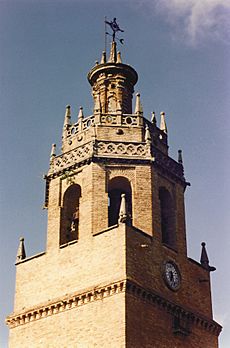
Hearst Castle featured 56 bedrooms, 61 bathrooms, 19 sitting rooms, 127 acres (0.5 km2) of gardens, indoor and outdoor swimming pools, tennis courts, a movie theater, an airfield, and the world's largest private zoo. Zebras and other exotic animals still roam the grounds. Morgan, an accomplished civil engineer, devised a gravity-based water delivery system that transports water from artesian wells on the slopes of Pine Mountain, a 3,500-foot (1,100 m) high peak 7 miles (11 km) east of Hearst Castle, to a reservoir on Rocky Butte, a 2,000-foot (610 m) knoll less than a mile southeast from Hearst Castle.

One highlight of the estate is the outdoor Neptune Pool, located near the edge of the hilltop, which offers an expansive vista of the mountains, ocean and the main house. Due to drought conditions and leaks in the pool, it is now drained. The Neptune Pool patio features an ancient Roman temple front, transported wholesale from Europe and reconstructed at the site. Hearst was an inveterate tinkerer, and would tear down structures and rebuild them on a whim. For example, the Neptune Pool was rebuilt three times before Hearst was satisfied. As a consequence of Hearst's persistent design changes, the estate was never completed in his lifetime.
Although Hearst Castle's ornamentation is borrowed from historic European themes, its underlying structure is primarily steel reinforced concrete. The use of modern engineering techniques reflects Morgan's background as a civil engineering graduate of the University of California, Berkeley and the first female architecture graduate of the École nationale supérieure des Beaux-Arts in Paris. Morgan designed tiles for the castle, and used several tile companies to produce them: Solon & Schemmel (San Jose), Grueby Faience Company (Boston), Batchelder (Pasadena), and California Faience (Berkeley). Albert Solon and Frank Schemmel came to Hearst Castle to perform the tile work.
During Hearst's ownership, a private power plant supplied electricity to the remote location. Most of the estate's chandeliers have bare light bulbs, because electrical technology was so new when Hearst Castle was built.
Size
The total square footage of the buildings on the estate exceeds 90,000 square feet (8,300 m²). The area of Casa Grande, the "castle", is 60,645 square feet (5,634 m²). The areas of the guest houses on the property are:
- Casa del Mar: 5,875 square feet (546 m²)
- Casa del Monte: 2,291 square feet (213 m²)
- Casa del Sol: 2,604 square feet (242 m²)
Gallery
Images for kids
-
The Church of Santa María la Mayor, Ronda – Hearst's main inspiration
-
A Greek rhyton
-
Gérôme's Bonaparte Before the Sphinx, which hangs in the sitting room of the Celestial Suite
See also
 In Spanish: Castillo Hearst para niños
In Spanish: Castillo Hearst para niños




